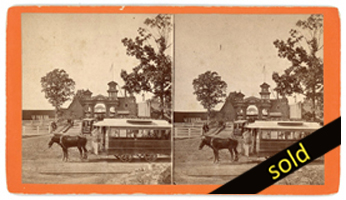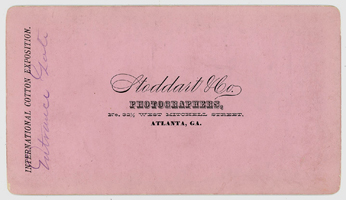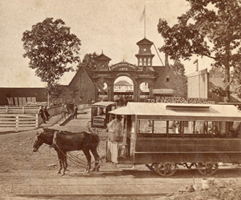TROLLEY AT THE ENTRANCE GATE OF THE 1881 INTERNATIONAL COTTON EXPOSITION, ATLANTA
STEREOVIEW $160. USD
Printed on the back: "INTERNATIONAL COTTON EXPOSITION." Handwritten below that: "Entrance Gate."
The entrance to the International Cotton Exposition is in the background, with text above the center arch: "OGLETHORPE PARK 1870 ENTRANCE." There's a carriage in the middle of the scene, with text on the back: "JACKS." A horse drawn trolley is in the foreground, with text at the top: "MARIETTA STREET TO EXPOSITION GROUNDS."
BACKMARK. "Stoddart & Co. PHOTOGRAPHERS, No. 32 1/2 WEST MITCHELL STREET, ATLANTA, GA."
SIZE. Approximately 3 15/16 x 7 inches.
CONDITION. Both sides: Some soiling. Some foxing. Mount: Wear around edges and at corners. Front has a scratch at the top and light soiling. Back has soiling.
APPEARANCE. Very good tones. Excellent depth of field. Masterful composition. This is a very cool stereoview.
OGLETHORPE PARK. "Oglethorpe Park was a municipal park in Atlanta, Georgia, United States. The park, consisting of about 50 acres (20 ha), was created in 1869 and hosted numerous fairs, most notably the International Cotton Exposition in 1881. Following this exposition, the park was sold by the city and was converted into the Exposition Cotton Mills, utilizing facilities that had been built for the event. The closure of the park indirectly contributed to the creation of two later parks in Atlanta: Grant Park and Piedmont Park." (source: Wikipedia)
INTERNATIONAL COTTON EXPOSITION. "Atlanta held its first exposition, named the International Cotton Exposition, in Oglethorpe Park in 1881. The city then had fewer than 40,000 residents, and the primary sense in which the first exposition was "international" was the display of cotton plants from around the world. Nevertheless, Atlantans were eager to host the 1881 exposition to promote investment and to help the city toward its goal of becoming an industrial center, which was a primary component of Grady's "New South" concept. Although attendance was lower than expected (fewer than 200,000 in paid attendance during its two-and-a-half-month run), city leaders demonstrated that they could work together to host a major event and that Atlanta was serious about its role in textile production at a time when the North was beginning to grow dissatisfied with the efficiency of southern cotton processing. The exposition displayed new crop planters and cotton seed cleaners, along with a model of Eli Whitney's original cotton gin, and speakers addressed the crowds about agricultural technology and political reforms." (source: New Georgia Encyclopedia)


